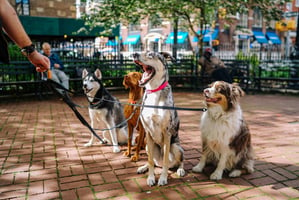Training a dog to answer Google's most popular queries can be a rewarding experience for both you...
How to Train a Dog Not to Bark: A Comprehensive Guide
Training a dog not to bark can be a challenging and rewarding task. It requires patience and consistency, but with the right techniques, your pup will learn the proper etiquette in no time. This comprehensive guide will provide you with the information and tips you need to train your dog not to bark and help keep your home peaceful and serene.
Understand Why Dogs Bark
Before you can begin training your pup not to bark, it is important to understand why dogs bark in the first place. Dogs bark to communicate their feelings and alert their owners of something out of the ordinary. They may bark to alert you of an intruder, to get attention, or to communicate they need to go outside. Understanding why dogs bark can help you better train them not to bark.
Establish a Barking Threshold
Once you understand why your pup barks, it is important to establish a barking threshold. This means determining how much barking is acceptable and how much is too much. For example, if your pup barks to alert you of an intruder, it is okay if they bark a few times, but if they bark continuously, it is too much. Establishing a barking threshold will help you determine when your pup needs to be trained not to bark.
Provide Positive Reinforcement
Positive reinforcement is one of the best ways to train a dog not to bark. When your pup is quiet, reward them with treats or praise. This will help them to understand that being quiet is the desired behavior. Additionally, it is important to avoid punishing your pup for barking. This can lead to fear and anxiety and can make it harder for them to learn the desired behavior.
Ignore Unwanted Barking
Ignoring unwanted barking is another effective way to train a dog not to bark. When your pup starts barking, turn away from them and ignore them. This will let them know that barking is not the desired behavior. It is important to remain consistent with this technique and to not give in and pay attention to your pup if they continue to bark.
Teach Your Dog a “Quiet” Cue
Teaching your pup a “quiet” cue is a great way to train them not to bark. When your pup starts barking, use the cue word “quiet” to signal that they need to stop. Once they are quiet, reward them with treats or praise. This will help them to understand that the cue means they need to be quiet. It is important to remain consistent with this technique and to use the cue word each time your pup barks.
Create a Calm Environment
Creating a calm environment can also be helpful in training your pup not to bark. Make sure to provide them with plenty of exercise and mental stimulation to help keep them calm and relaxed. Additionally, make sure to keep their environment free of triggers that may cause them to bark, such as loud noises or visitors. This will help to keep your pup calm and will make it easier for them to learn the desired behavior.
Consult a Professional Trainer
If you are having difficulty training your pup not to bark, consulting a professional trainer can be beneficial. Professional trainers are experienced in working with dogs and can provide you with tips and advice to help you train your pup. Additionally, they can help you identify any underlying issues that may be causing your pup to bark and can help you create a training plan that is tailored to your pup’s specific needs.
Conclusion
Training a dog not to bark can be a challenging and rewarding task. It requires patience and consistency, but with the right techniques, your pup will learn the proper etiquette in no time. Understanding why dogs bark, establishing a barking threshold, providing positive reinforcement, ignoring unwanted barking, teaching your pup a “quiet” cue, and creating a calm environment are all effective ways to train your pup not to bark. Additionally, consulting a professional trainer can be beneficial if you are having difficulty training your pup. With the right techniques, your pup will learn the proper etiquette and your home will be peaceful and serene.



